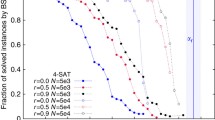Abstract
The heavy-tailed phenomenon that characterises the runtime distributions of backtrack search procedures has received considerable attention over the past few years. Some have conjectured that heavy-tailed behaviour is largely due to the characteristics of the algorithm used. Others have conjectured that problem structure is a significant contributor. In this paper we attempt to explore the former hypothesis, namely we study how variable and value ordering heuristics impact the heavy-tailedness of runtime distributions of backtrack search procedures. We demonstrate that heavy-tailed behaviour can be eliminated from particular classes of random problems by carefully selecting the search heuristics, even when using chronological backtrack search. We also show that combinations of good search heuristics can eliminate heavy tails from quasigroups with holes of order 10 and 20, and give some insights into why this is the case. These results motivate a more detailed analysis of the effects that variable and value orderings can have on heavy-tailedness. We show how combinations of variable and value ordering heuristics can result in a runtime distribution being inherently heavy-tailed. Specifically, we show that even if we were to use an oracle to refute insoluble subtrees optimally, for some combinations of heuristics we would still observe heavy-tailed behaviour. Finally, we study the distributions of refutation sizes found using different combinations of heuristics and gain some further insights into what characteristics tend to give rise to heavy-tailed behaviour.
Similar content being viewed by others
References
Achlioptas, D., Gomes, C. P., Kautz, H. A., & Selman, B. (2000). Generating satisfiable problem instances. In Proceedings of AAAI-2000, (pp. 256–261).
Bessière, C., Fernández, C., Gomes, C. P., & Valls, M. (2004). Pareto-like distributions in random binary csp. In Proceedings of ACIA-2003.
Bessière, C., & Regin, J.-C. (1996). MAC and combined heuristics: Two reasons to forsake FC (and CBJ?) on hard problems. In Proceedings of CP-1996, LNCS 1118, (pp. 61–75).
Boussemart, F., Hemery, F., Lecoutre, C., & Sais, L. (2004). Boosting systematic search by weighting constraints. In Proceedings of ECAI-2004, (pp. 146–150).
Brélaz, D. (1979). New methods to color the vertices of a graph. Communications of the ACM, 22(4), 251–256.
Chen, H., Gomes, C. P., & Selman, B. (2001). Formal models of heavy-tailed behavior in combinatorial search. In Proceedings of CP-2001, (pp. 408–421).
Colbourn, C. (1983). Embedding partial steiner triple systems is NP-complete. Combinatorial Theory, A(35), 100–105.
Davenport, A., & Tsang, E. (1995). An empirical investigation into the exceptionally hard problems. Technical Report CSM-239, Department of Computer Science, University of Essex, UK.
Gent, I. P., MacIntyre, E., Prosser, P., Smith, B. M., & Walsh, T. (2001). Random constraint satisfaction: Flaws and structure. Constraints, 6(4), 345–372.
Gent, I. P., & Walsh, T. (1994). Easy problems are sometimes hard. Artificial Intelligence, 70, 335–345.
Gomes, C. P. (2003). Randomized backtrack search. Constraint and Integer Programming, (pp. 233–283).
Gomes, C. P., Fernández, C., Selman, B., & Bessière, C. (2004). Statistical regimes across constrainedness regions. In Proceedings of CP-2004, LNCS 3258, (pp. 32–46).
Gomes, C. P., Fernández, C., Selman, B., & Bessière, C. (2005). Statistical regimes across constrainedness regions. Constraints, 10(4), 317–337.
Gomes, C. P., Selman, B., & Crato, N. (1997). Heavy-tailed distributions in combinatorial search. In Proceedings of CP-1997, (pp. 121–135).
Gomes, C. P., Selman, B., Crato, N., & Kautz, H. (2000). Heavy-tailed phenomena in satisfiability and constraint satisfaction problems. Automated Reasoning, 24(1/2), 67–100.
Haralick, R. M., & Elliott, G. L. (1980). Increasing tree search efficiency for constraint satisfaction problems. Artificial Intelligence, 14(3), 263–313.
Hogg, T., & Williams, C. P. (1994). The hardest constraint problems: A double phase transition. Artificial Intelligence, 69, 359–377.
Hulubei, T., & O’Sullivan, B. (2005). Optimal refutations for constraint satisfaction problems. In Proceedings of IJCAI-2005, (pp. 163–168).
Hulubei, T., & O’Sullivan, B. (2005). Search heuristics and heavy-tailed behaviour. In Proceedings of CP-2005, (pp. 328–342).
Jacobson, M. T., & Matthews, P. (1996). Generating uniformly distributed random latin squares. Combinatorial Design, 4, 405–437.
Kautz, H. A., Ruan, Y., Achlioptas, D., Gomes, C. P., Selman, B., & Stickel, M. E. (2001). Balance and filtering in structured satisfiable problems. In Proceedings of IJCAI-2001, (pp. 351–358).
Korf, R. E. (1985). Depth-first iterative-deepening: An optimal admissible tree search. Artificial Intelligence, 27(1), 97–109.
Lecoutre, C., Boussemart, F., & Hemery, F. (2004). Backjump-based techniques versus conflictdirected heuristics. In Proceedings of ICTAI-2004, (pp. 549–557).
Sabin, D., & Freuder, E. C. (1994). Contradicting conventional wisdom in constraint satisfaction. In Proceedings of ECAI-1994, (pp. 125–129).
Smith, B. M. (1995). In search of exceptionally difficult constraint satisfaction problems. In Constraint Processing, Selected Papers, LNCS 923, (pp. 139–156).
Smith, B. M., & Grant, S. (1995). Sparse constraint graphs and exceptionally hard problems. In Proceedings of IJCAI-1995, (pp. 646–651).
Smith, B. M., & Sturdy, P. (2004). An empirical investigation of value ordering for finding all solutions. In Workshop on Modelling and Solving Problems with Constraints.
Walsh, T. (1999). Search in a small world. In Proceedings of IJCAI-1999, (pp. 1172–1177).
Author information
Authors and Affiliations
Corresponding author
Rights and permissions
About this article
Cite this article
Hulubei, T., O’Sullivan, B. The Impact of Search Heuristics on Heavy-Tailed Behaviour. Constraints 11, 159–178 (2006). https://doi.org/10.1007/s10601-006-8061-1
Published:
Issue Date:
DOI: https://doi.org/10.1007/s10601-006-8061-1




